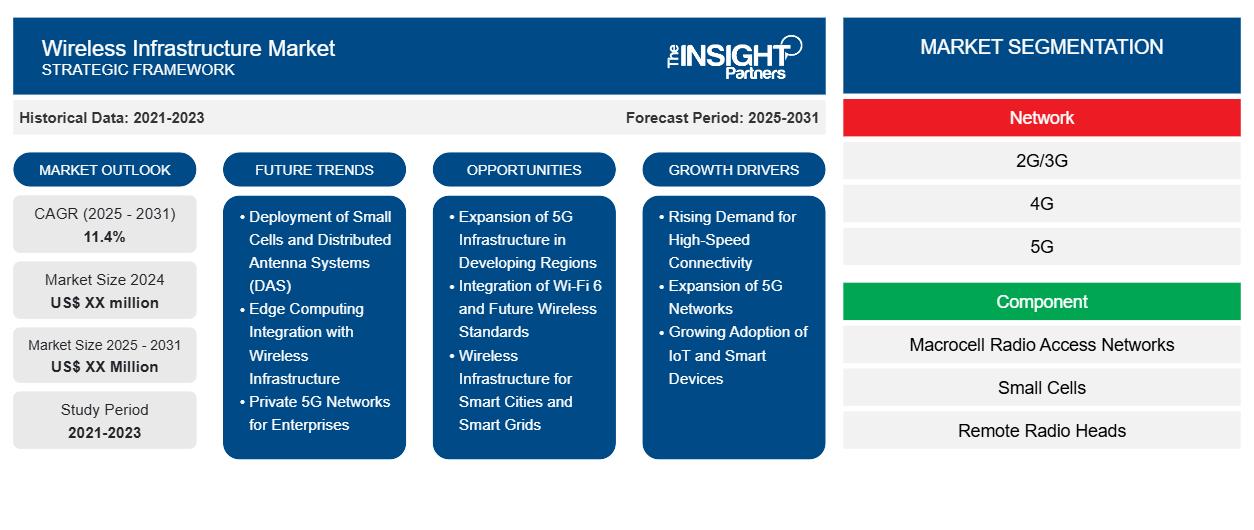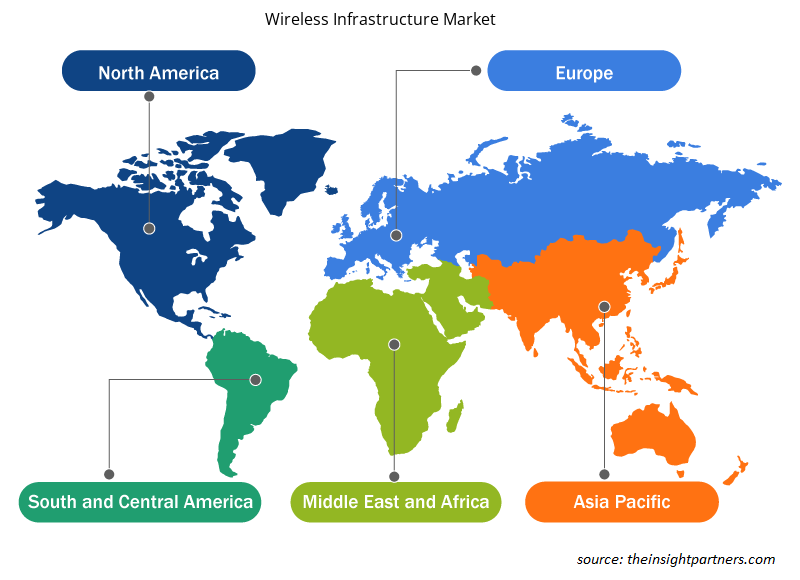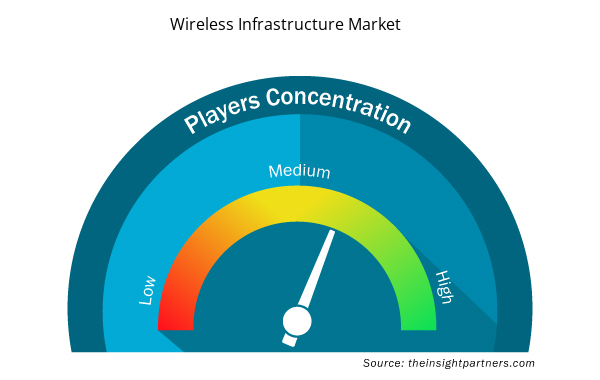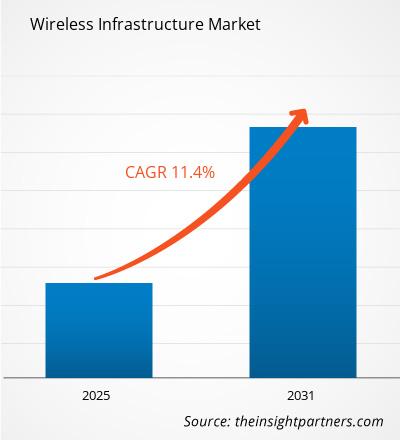The Wireless Infrastructure Market is expected to register a CAGR of 11.4% from 2025 to 2031, with a market size expanding from US$ XX million in 2024 to US$ XX Million by 2031.
The report is segmented by Network (2G/3G, 4G, 5G); Component (Macrocell Radio Access Networks (RAN), Small Cells, Remote Radio Heads (RRH), Distributed Antenna Systems (DAS), Cloud RAN, Carrier Wi-Fi, Mobile Core, Backhaul). The global analysis is further broken-down at regional level and major countries. The Report Offers the Value in USD for the above analysis and segments.
Purpose of the Report
The report Wireless Infrastructure Market by The Insight Partners aims to describe the present landscape and future growth, top driving factors, challenges, and opportunities. This will provide insights to various business stakeholders, such as:
- Technology Providers/Manufacturers: To understand the evolving market dynamics and know the potential growth opportunities, enabling them to make informed strategic decisions.
- Investors: To conduct a comprehensive trend analysis regarding the market growth rate, market financial projections, and opportunities that exist across the value chain.
- Regulatory bodies: To regulate policies and police activities in the market with the aim of minimizing abuse, preserving investor trust and confidence, and upholding the integrity and stability of the market.
Wireless Infrastructure Market Segmentation
Network
- 2G/3G
- 4G
- 5G
Component
- Macrocell Radio Access Networks
- Small Cells
- Remote Radio Heads
- Distributed Antenna Systems
- Cloud RAN
- Carrier Wi-Fi
- Mobile Core
- Backhaul
Customize This Report To Suit Your Requirement
You will get customization on any report - free of charge - including parts of this report, or country-level analysis, Excel Data pack, as well as avail great offers and discounts for start-ups & universities
Wireless Infrastructure Market: Strategic Insights

- Get Top Key Market Trends of this report.This FREE sample will include data analysis, ranging from market trends to estimates and forecasts.
Wireless Infrastructure Market Growth Drivers
- Rising Demand for High-Speed Connectivity: The increasing demand for high-speed internet, fueled by the growth of digitalization, remote working, and cloud-based services, is one of the major drivers of the wireless infrastructure market. As consumers and businesses require faster and more reliable connectivity, telecommunication companies are investing heavily in advanced wireless networks like 5G to meet these expectations, propelling the market forward.
- Expansion of 5G Networks: The global roll-out of 5G technology is significantly driving the demand for wireless infrastructure. 5G networks promise ultra-low latency, higher speeds, and the ability to support a larger number of connected devices, which is essential for emerging technologies like the Internet of Things (IoT) and autonomous vehicles. This expansion is pushing the wireless infrastructure market to innovate and upgrade existing network systems to handle the increased demand.
- Growing Adoption of IoT and Smart Devices: The widespread adoption of IoT devices across sectors like healthcare, manufacturing, automotive, and smart homes is creating a need for robust wireless infrastructure. IoT relies on stable and efficient wireless networks for real-time data transmission and connectivity. The increasing deployment of smart devices has amplified the need for reliable and scalable wireless infrastructure, driving market growth
Wireless Infrastructure Market Future Trends
- Deployment of Small Cells and Distributed Antenna Systems (DAS): With the expansion of 5G and the increased demand for seamless connectivity in densely populated areas, small cells and Distributed Antenna Systems (DAS) are becoming popular solutions. These technologies are being implemented to fill coverage gaps, enhance capacity, and provide better connectivity in urban environments. This trend is expected to continue as urban areas evolve to accommodate higher data traffic.
- Edge Computing Integration with Wireless Infrastructure: The integration of edge computing with wireless infrastructure is an emerging trend that enhances the performance of networks by processing data closer to the source. This reduces latency, improves speed, and optimizes data traffic management. With the increasing need for real-time data processing for applications such as autonomous vehicles, industrial automation, and smart cities, edge computing is becoming a vital part of wireless network deployment.
- Private 5G Networks for Enterprises: The rise of private 5G networks is a notable trend in the wireless infrastructure market, particularly for businesses looking to leverage high-speed connectivity for specific applications such as manufacturing, logistics, and healthcare. These private networks offer greater security, lower latency, and better performance than public networks. Companies are investing in private 5G solutions to support mission-critical operations, ensuring more control over their networks
Wireless Infrastructure Market Opportunities
- Expansion of 5G Infrastructure in Developing Regions: There is a significant opportunity for wireless infrastructure growth in emerging markets, particularly in regions like Asia-Pacific, Africa, and Latin America. As these regions experience rapid urbanization and digital transformation, the demand for 5G infrastructure will rise. Telecom providers and governments are investing in 5G deployment in these markets, opening avenues for growth in wireless infrastructure, especially in rural and underserved areas.
- Integration of Wi-Fi 6 and Future Wireless Standards: With the increasing number of connected devices and the need for faster, more reliable internet, the adoption of Wi-Fi 6 technology is on the rise. This new standard offers faster speeds, lower latency, and improved performance in high-density environments. As businesses and consumers demand better connectivity, the integration of Wi-Fi 6 in existing wireless infrastructure presents a major opportunity for innovation and growth in the market.
- Wireless Infrastructure for Smart Cities and Smart Grids: The rise of smart cities and smart grids offers considerable growth potential for the wireless infrastructure market. These cities require advanced wireless systems to support applications like intelligent transportation, energy management, and public safety. As cities across the globe invest in becoming more connected and sustainable, the demand for wireless infrastructure solutions will increase, presenting new business opportunities in sectors like urban planning, energy, and public services
Wireless Infrastructure Market Regional Insights
The regional trends and factors influencing the Wireless Infrastructure Market throughout the forecast period have been thoroughly explained by the analysts at Insight Partners. This section also discusses Wireless Infrastructure Market segments and geography across North America, Europe, Asia Pacific, Middle East and Africa, and South and Central America.

- Get the Regional Specific Data for Wireless Infrastructure Market
Wireless Infrastructure Market Report Scope
| Report Attribute | Details |
|---|---|
| Market size in 2024 | US$ XX million |
| Market Size by 2031 | US$ XX Million |
| Global CAGR (2025 - 2031) | 11.4% |
| Historical Data | 2021-2023 |
| Forecast period | 2025-2031 |
| Segments Covered |
By Network
|
| Regions and Countries Covered | North America
|
| Market leaders and key company profiles |
Wireless Infrastructure Market Players Density: Understanding Its Impact on Business Dynamics
The Wireless Infrastructure Market market is growing rapidly, driven by increasing end-user demand due to factors such as evolving consumer preferences, technological advancements, and greater awareness of the product's benefits. As demand rises, businesses are expanding their offerings, innovating to meet consumer needs, and capitalizing on emerging trends, which further fuels market growth.
Market players density refers to the distribution of firms or companies operating within a particular market or industry. It indicates how many competitors (market players) are present in a given market space relative to its size or total market value.
Major Companies operating in the Wireless Infrastructure Market are:
- ADTRAN, Inc.
- Cisco Systems, Inc.
- Ericsson
- Huawei Technologies Co., Ltd.
- Motorola Solutions, Inc.
Disclaimer: The companies listed above are not ranked in any particular order.

- Get the Wireless Infrastructure Market top key players overview
Key Selling Points
- Comprehensive Coverage: The report comprehensively covers the analysis of products, services, types, and end users of the Wireless Infrastructure Market, providing a holistic landscape.
- Expert Analysis: The report is compiled based on the in-depth understanding of industry experts and analysts.
- Up-to-date Information: The report assures business relevance due to its coverage of recent information and data trends.
- Customization Options: This report can be customized to cater to specific client requirements and suit the business strategies aptly.
The research report on the Wireless Infrastructure Market can, therefore, help spearhead the trail of decoding and understanding the industry scenario and growth prospects. Although there can be a few valid concerns, the overall benefits of this report tend to outweigh the disadvantages.
- Historical Analysis (2 Years), Base Year, Forecast (7 Years) with CAGR
- PEST and SWOT Analysis
- Market Size Value / Volume - Global, Regional, Country
- Industry and Competitive Landscape
- Excel Dataset



Report Coverage
Revenue forecast, Company Analysis, Industry landscape, Growth factors, and Trends

Segment Covered
This text is related
to segments covered.

Regional Scope
North America, Europe, Asia Pacific, Middle East & Africa, South & Central America

Country Scope
This text is related
to country scope.
Frequently Asked Questions
Some of the customization options available based on the request are an additional 3-5 company profiles and country-specific analysis of 3-5 countries of your choice. Customizations are to be requested/discussed before making final order confirmation# as our team would review the same and check the feasibility
The report can be delivered in PDF/PPT format; we can also share excel dataset based on the request
The Technological Advancements such as Edge Computing along with Wi-Fi 6 and Wi-Fi 7 is anticipated to play a significant role in the global Wireless Infrastructure market in the coming years
The major factors driving the Wireless Infrastructure market are Increased Mobile Data Usage and Internet of Things (IoT) Expansion.
The Wireless Infrastructure Market is estimated to witness a CAGR of 11.4% from 2023 to 2031
-
Trends and growth analysis reports related to Electronics and Semiconductor : READ MORE..
1. ADTRAN, Inc.
2. Cisco Systems, Inc.
3. Ericsson
4. Huawei Technologies Co., Ltd.
5. Motorola Solutions, Inc.
6. NEC Corporation
7. Nokia Corporation
8. Qualcomm Technologies, Inc.
9. Samsung
10. ZTE Corporation

 Get Free Sample For
Get Free Sample For